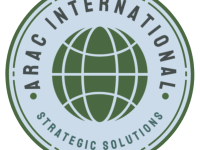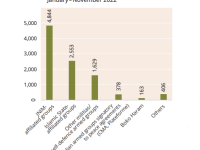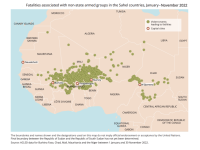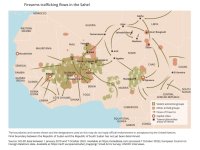News
FIREARMS TRAFFICKING IN THE SAHEL
UNODC Analysis
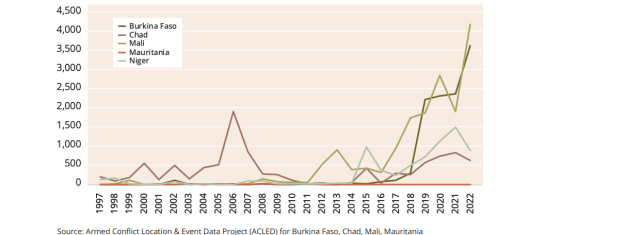
(Source: UNODC)
ARARC International Strategic Communications -
From ReliefWeb
Source:UNODC Posted:14 Feb 2023 Originally published:14 Feb 2023 Origin:View original
For the purpose of this report, “Sahel countries” refers to Burkina Faso, Chad, Mali, Mauritania and the Niger.
There is often no clear delineation between violent crime
and conflict in the Sahel countries and the sine qua non
of both is firearms.1 Groups of armed men are involved
in all manner of violent and acquisitive crime in the region, which has known several periods of upheaval since
the 1990s (figure 1).2 Several mutually reinforcing factors have contributed to the growth of both insurgency
and banditry in the Sahel, including intercommunal
tensions, violence between farmers and herders, violent religious extremism and competition over scarce
resources such as water and arable land.3 The longer
the region remains insecure, the more people are likely to take up arms there. From the perspective of the
victims of violence, it matters little whether the motivation is criminal or political.
Source:UNODC Posted:14 Feb 2023 Originally published:14 Feb 2023 Origin:View original
For the purpose of this report, “Sahel countries” refers to Burkina Faso, Chad, Mali, Mauritania and the Niger.
There is often no clear delineation between violent crime
and conflict in the Sahel countries and the sine qua non
of both is firearms.1 Groups of armed men are involved
in all manner of violent and acquisitive crime in the region, which has known several periods of upheaval since
the 1990s (figure 1).2 Several mutually reinforcing factors have contributed to the growth of both insurgency
and banditry in the Sahel, including intercommunal
tensions, violence between farmers and herders, violent religious extremism and competition over scarce
resources such as water and arable land.3 The longer
the region remains insecure, the more people are likely to take up arms there. From the perspective of the
victims of violence, it matters little whether the motivation is criminal or political.
Key takeaways
~Although more than 9,300 people died in violent incidents in the Sahel countries in 2022, the single greatest source of violent incidents is not related to clashes between armed groups and pro-governmental forces.
~Several mutually reinforcing factors have contributed to the growth of both insurgency and banditry, including intercommunal tensions, violence between farmers and herders, violent religious extremism and competition over scarce resources such as water and arable land. Environmental factors such as climate change may also be having an impact on conflicts in the Sahel. All the groups involved require firearms and ammunition, and as their numbers multiply so too do business opportunities for arms traffickers in the Sahel countries.
~While there is evidence of long-range firearms trafficking to the Sahel, including by air from France and from Turkey via Nigeria, it appears that the vast majority of firearms trafficked in the region are procured within Africa.
~Although more than 9,300 people died in violent incidents in the Sahel countries in 2022, the single greatest source of violent incidents is not related to clashes between armed groups and pro-governmental forces.
~Several mutually reinforcing factors have contributed to the growth of both insurgency and banditry, including intercommunal tensions, violence between farmers and herders, violent religious extremism and competition over scarce resources such as water and arable land. Environmental factors such as climate change may also be having an impact on conflicts in the Sahel. All the groups involved require firearms and ammunition, and as their numbers multiply so too do business opportunities for arms traffickers in the Sahel countries.
~While there is evidence of long-range firearms trafficking to the Sahel, including by air from France and from Turkey via Nigeria, it appears that the vast majority of firearms trafficked in the region are procured within Africa.
~Since 2019, Libya has become a source of supply for newly manufactured weapons.
Apparently, newly produced AK-pattern assault rifles, sourced from Libya, are available on the black market in Gao, Timbuktu and Ménaka regions of northern Mali.
~Evidence shows that the diversion of weapons from national armed forces – whether through capture on the battlefield, theft from armouries, or purchase from corrupt elements in the military – is the primary source of firearms in the Sahel countries today.
~The AK-type models that make up a large share of the assault rifles in the Sahel are durable and often still effective in combat decades after their manufacture. Rebels who participated in the 1990 Tuareg rebellions in Mali and the Niger, as well as previous uprisings, retained many of their arms, which were either held in caches or in the possession of individuals.
~As well as remaining in the region, weapons trafficked in the Sahel also make their way to the coastal countries of West Africa and have been used in terrorist attacks in the Gulf of Guinea.
Apparently, newly produced AK-pattern assault rifles, sourced from Libya, are available on the black market in Gao, Timbuktu and Ménaka regions of northern Mali.
~Evidence shows that the diversion of weapons from national armed forces – whether through capture on the battlefield, theft from armouries, or purchase from corrupt elements in the military – is the primary source of firearms in the Sahel countries today.
~The AK-type models that make up a large share of the assault rifles in the Sahel are durable and often still effective in combat decades after their manufacture. Rebels who participated in the 1990 Tuareg rebellions in Mali and the Niger, as well as previous uprisings, retained many of their arms, which were either held in caches or in the possession of individuals.
~As well as remaining in the region, weapons trafficked in the Sahel also make their way to the coastal countries of West Africa and have been used in terrorist attacks in the Gulf of Guinea.
~To enable communities to defend themselves against extremist groups, some States in the region have armed militias or other non-state actors, whose weapons are even more likely to be diverted than those entrusted to official national security structures.
~Despite there being numerous sources of manufactured firearms, the large market for artisanal weapons made in West and Central Africa implies that there are limits to the supply. While violent extremist groups linked to Al Qaida and Islamic State are more likely to use industrially manufactured weapons, other non-state armed groups, such as traditional hunter groups and other community militias, may prefer artisanal weapons because they are cheaper.
~Open markets selling firearms in the Sahel are often located in small towns and villages along strategic corridors. Many of the areas known as being hubs for weapons trafficking are simply areas with a low state presence along borders or transportation routes where multiple criminal activities take place.
~Despite there being numerous sources of manufactured firearms, the large market for artisanal weapons made in West and Central Africa implies that there are limits to the supply. While violent extremist groups linked to Al Qaida and Islamic State are more likely to use industrially manufactured weapons, other non-state armed groups, such as traditional hunter groups and other community militias, may prefer artisanal weapons because they are cheaper.
~Open markets selling firearms in the Sahel are often located in small towns and villages along strategic corridors. Many of the areas known as being hubs for weapons trafficking are simply areas with a low state presence along borders or transportation routes where multiple criminal activities take place.
~As the supply chains and traffickers are many and varied, it appears that the number of individuals who are primarily involved in large-scale arms trafficking in the Sahel countries is limited. Rather, it seems that weapons are exchanged in an opportunistic way depending on shifts in supply and demand.
~Ethnic connections can be important facilitators of arms trafficking across national borders in the Sahel. Many of the conflicts in the region have an ethnic dimension, as do criminal groups, who may prefer to sell or transfer firearms to co-ethnics in other countries. Nonetheless, in some cases, similar weapons have been confiscated from very different groups, suggesting that they share a common source of supply or that they exchange firearms.
~Violent extremist groups are not primarily engaged in firearms trafficking in the Sahel.
However, they may have a “client-seller” relationship with the communities and other armed groups they interact with, and are only likely to receive an indirect financial benefit from the use of firearms rather than from their trafficking.
~Ethnic connections can be important facilitators of arms trafficking across national borders in the Sahel. Many of the conflicts in the region have an ethnic dimension, as do criminal groups, who may prefer to sell or transfer firearms to co-ethnics in other countries. Nonetheless, in some cases, similar weapons have been confiscated from very different groups, suggesting that they share a common source of supply or that they exchange firearms.
~Violent extremist groups are not primarily engaged in firearms trafficking in the Sahel.
However, they may have a “client-seller” relationship with the communities and other armed groups they interact with, and are only likely to receive an indirect financial benefit from the use of firearms rather than from their trafficking.
~Militant control of transportation routes is key to successful arms trafficking in the Sahel. The limited number of ways of crossing the Sahara Desert means that the groups that are in position to tax and control trans-Sahara trade can raise funds to purchase firearms and protect their goods.
~In the Sahel, investigations and court decisions often only link firearms offences with illicit possession. Firearms are usually treated as tools for committing crime or as evidence.
Addressing the illicit origin of and trafficking in firearms is the only possible way to target the perpetrators at the source of trafficking networks.
~In the Sahel, investigations and court decisions often only link firearms offences with illicit possession. Firearms are usually treated as tools for committing crime or as evidence.
Addressing the illicit origin of and trafficking in firearms is the only possible way to target the perpetrators at the source of trafficking networks.
=====================================================
ARAC International, Strategic Communications & Analysis
Global Security Analyst | Human Rights Consultant
In partnership with the U.S. Agency for International Development (USAID)
Certified by the U.S. Institute for Diplomacy and Human Rights
Institute for Economics and Peace Ambassador
https:/iep.arac-international.org
ARAC International, Strategic Communications & Analysis
Global Security Analyst | Human Rights Consultant
In partnership with the U.S. Agency for International Development (USAID)
Certified by the U.S. Institute for Diplomacy and Human Rights
Institute for Economics and Peace Ambassador
https:/iep.arac-international.org
more information: https://www.arac-international.org/2023/02/firearms-trafficking-in-sahel.html
Liability for this article lies with the author, who also holds the copyright. Editorial content from USPA may be quoted on other websites as long as the quote comprises no more than 5% of the entire text, is marked as such and the source is named (via hyperlink).

